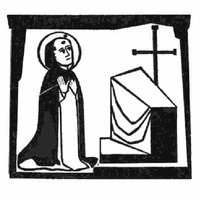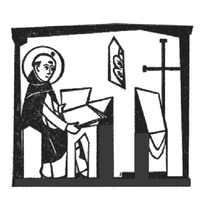
St. Dominic's Nine Ways of Prayer by S. Chris Broslavick
St. Dominic’s ways of prayer stirred the curiosity of his brothers. It is said that they would watch him pray. They did so from an upper window. They saw what was recorded as Dominic’s nine ways of prayer, nine different postures or gestures. They often heard him recite or cry out the words of scripture. The nine ways are uncommon to our present time; therefore a brief preface may be helpful.
From a historical perspective, there emerged in the late 12th century Church in Spain a religious group that had a great influence upon the people. Their belief that the body was evil and that the soul was good was preached in word and action. This religious group was very austere, and self-punishing. Some of Dominic’s ways of prayer were reflective of that thinking.
From a philosophical perspective, the Dominican Thomas Aquinas taught that certain attitudes and gestures of the body can dispose us for prayer and, conversely, that intense prayer can burst forth in a bodily expression.
From a psychological perspective, Sister Catherine Aubin, author of On Praying With the Body, According to St. Dominic, suggests that when one loves, that love is manifested with gestures, words, smiles. This also happens in prayer.
From a biblical anthropological perspective, Aubin recalls that specific, dynamic functions are given to the different parts of the body. For example, the neck may symbolize the place of honor, of weight, but also of affection or humility; hence, the bow. It is within these various contexts that we examine Dominic’s nine ways of prayer:

THE FIRST WAY OF PRAYER IS THE BOW
In the Dominican Tradition,
there are three forms of this gesture:
the simple bow of the head,
a bow from the shoulders, and
the profound bow from the waist.
Early drawings of Dominic at prayer before the altar of the crucified Christ show him bowing profoundly. Various texts say that standing erect; Dominic bowed his head and humbly considered the bowed head of the crucified Christ. He humbled himself before the Christ who took on the humiliation of the cross. And the brothers would hear him praying: “I am not worthy that you should come under my roof.” [Mt 8:8]
“I have been humbled before you exceedingly, Oh Lord.” [Ps 118:107]
“Oh, Lord, God, the prayer of the humble and meek has always pleased you.” [Jd 9:16]
Dominic taught the brothers to humble themselves before the crucified Christ and to humble themselves before the Trinity as they chanted the Glory Be. This same gesture continues in some Dominican congregations today.
When do you observe others/yourself bow? How can this gesture be intentional in your prayer? What is your body “saying” in the gesture of a bow?

IN THE SECOND WAY OF PRAYER
Dominic laid face down, outstretched on the floor. It was said that he assumed this posture when overtaken with great sorrow, and he wept. Sometimes in a voice loud enough to be heard, he would pray, “O God, be merciful to me, a sinner.” [Luke 18:13]
Dominic prayed with his entire body.
This is how Dominic taught his brothers
to pray for God’s mercy.
He further admonished,
“If you cannot weep for your own sins,
weep for the sins of others.”
In this way Dominic called upon God’s mercy for all.
For what sins and failings have you been brought low?
How have you wept for God’s mercy?
In what way do you pray for others in need of God’s mercy?

Rising to his knees from prostration as described in the second way of prayer, Dominic would scourge himself with an iron chain.
THIS THIRD WAY OF PRAYER was one of repentance. We need to remember the context of the time in which Dominic lived which provides an understanding of what would now appear an unacceptable form of prayer.
In memory of his example, the Order decreed that all the brothers should receive the discipline with wooden switches upon the shoulders. This was to be practiced on days without feasts while bowing and reciting, “Have mercy on me, O God, in your goodness; …wipe out my offenses.” [Miserere, PS 51]; or, “Out of the depths I cry to you, O Lord; Lord, hear my voice!” [De Profundis, Psalm130]
The scourging was done in repentance for the brother’s own faults and for the faults of others.
Humility, mercy and self-discipline
characterize Dominic’s first three ways of praying.
How does humility, mercy and self-discipline serve as a way to overcome faults?

As Dominic was transfixed upon the cross, he frequently genuflected. In awe of the crucified Christ, he would rise then kneel, rising and kneeling again and again.
GENUFLECTION BECAME DOMINIC’S FOURTH WAY OF PRAYER.
And in these postures a change would come over him and he would feel great confidence in God’s mercy toward himself, toward his brothers, toward all sinners. He could sometimes be heard murmuring, “Unto you will I cry, O Lord: O my God, be not silent to me…” [Ps. 27:1]
At other times he would remain in silent genuflection and it appeared as though a great joy brought him to tears. Then again he would rise and again kneel. It became Dominic’s intimate and personal form of worship. He taught his brothers to pray in this way by his example as he prayed this way not only in his room but also as he traveled.
Dominic, sometimes called “athlete of Christ,” prayed in ways that were physically demanding, physically disciplined. And he prayed with great grace and agility.
Today we typically genuflect when we enter and leave church/chapel.
Perhaps this is done as a form of Church etiquette.
If this is your practice, what are you thinking as you bend your knee?
If this is not your practice, what circumstances in your relationship with God, bring you to your knees?

IN THE FIFTH WAY OF PRAYING, Dominic stood with his hands held before him as if reading from a book.
It is said that he stood in such reverence as if to be reading the very presence of God.
He would then for a time clasp his hands together; at other times he would raise his hands as the priest does at liturgy. It appeared as though Dominic stood as a prophet who first spoke with God, listened deeply to God’s response and then lingered in silent thought of what had been revealed to him.
Examine your prayer:
How are you speaking to God, listening to God, contemplating what God has revealed woven into your prayer?
What are the natural postures or gestures you assume in prayer?

IN THE SIXTH WAY OF PRAYER, Dominic stood with outstretched arms, in the form of a cross. It is said that he prayed in this way in anticipation of a miracle that God would perform.
This is the way Dominic entreated God when a boy was raised to life in the Church of St. Sixtus in Rome, when Dominic himself was raised from the ground at the celebration of the Mass, and when a group of pilgrims was delivered from drowning in a river near Toulouse. So struck were those who observed this form of prayer that they failed to remember what Dominic said.
Dominic, in this reverent supplication, seemingly knew God’s intent to bring forth from the death of the cross, new life. “I stretched forth my hands to thee…Hear me speedily, O Lord.” Ps. 142:1-7)
In this imitation of Christ on the Cross, Dominic inspired the brethren but he neither encouraged nor discouraged them to pray in this manner.
Try it! Really! Are you able to maintain this posture for a minute, for two?
And, can you move beyond the discomfort to some kind of communion with God?

THE SEVENTH WAY OF PRAYER was supplication where Dominic’s whole being was seen as an arrow directed heavenward shot from a bow.
Raised above his head, Dominic’s hands were either joined together or slightly parted as if to be receiving something from heaven. In this way Dominic acknowledged that all good gifts are from God.
While in this posture Dominic seemed to enter into a state of bliss, and upon regaining his temporal awareness would pray, “Hear, O Lord, the voice of my supplication which I pray to thee, when I lift up my hands to thy holy temple.” (Ps. 27:2)
Recall a time or circumstance when you may have lost all awareness of time
and space. What prompted that experience?
How would that kind of intensity to your prayer?

THE EIGHTH WAY OF PRAYER, reflective reading, might be described as Dominic in table conversation with the Word.
Dominic would go off to some quiet place and seated at a table he would sign himself and begin to read a book.
Shortly it seemed that he was discussing something with a friend; he appeared at once to be listening quietly then discussing and arguing, and then laugh and weep, and then bow and speaking quietly beat his breast. It was as though Dominic found God in some way speaking to him through the words he read.
Dominic, it is said, appeared to move from reading to prayer, from prayer to meditation, from meditation to contemplation.
Recall when recently something you read moved you to prayer.
What would you require in order to bring your daily reading into conversation with God? Try this form of prayer!

THE NINTH WAY OF PRAYER, praying on the journey, is walking in solitude.
As Dominic and his companions traveled by foot from country to country, he would remove himself from their company and walk by himself.
This was meditative time for Dominic. It was time for him to meditate upon the scriptures and commune with the Holy Spirit. About his long solitary walk he would quote to his companions: “I will lead her (my spouse) into the wilderness and I will speak to her ear.” (Hosea 2:16) This was preparation for Dominic’s holy preaching.
Walk. Alone. Listen to the sounds of your environment—planes flying overhead, cars in distant traffic, sounds of industry. Turn your focus to the sounds of nature—birds chirping, leaves fluttering in the wind, crickets. Move your attention to the sound of your footsteps, your breathing, the sensation of your heartbeat.
Walk now into the deepest part of yourself and listen.
Can you hear God’s voice?
S. Chris Broslavick OP
